Diary entry, 6 June 1944: “Land (invasion) 07.30, little done in the morning, with inf in the afternoon[antry]4 pill boxes appeared. We met with the other AVREs at 17:00 (approximately).”
Much has been written about D-Day. While it wasn’t much, it turns out that my grandfather James “Jim” Baxter summed up his role in history’s largest naval invasion in just 20 words.
I didn’t know Jim. He survived Hitler but died suddenly of a heart attack in 1982, when I was four years old. I was told he used tanks during the war – heavy, specially designed Churchill AVREs (Armored Vehicle Royal Engineers) were used to bunker bust and clear obstacles – but until last Christmas I had no idea he kept a diary.
It had somehow emerged from among the festive whiskeys and been pulled off the shelf: a little red wallet, a week at a time, six little lines a day. It was small enough to fit into a tunic as it crossed the English Channel on its way to France. The entry dated June 5 reads: “Set at dawn, the sea is calm, many of the children are sick.”
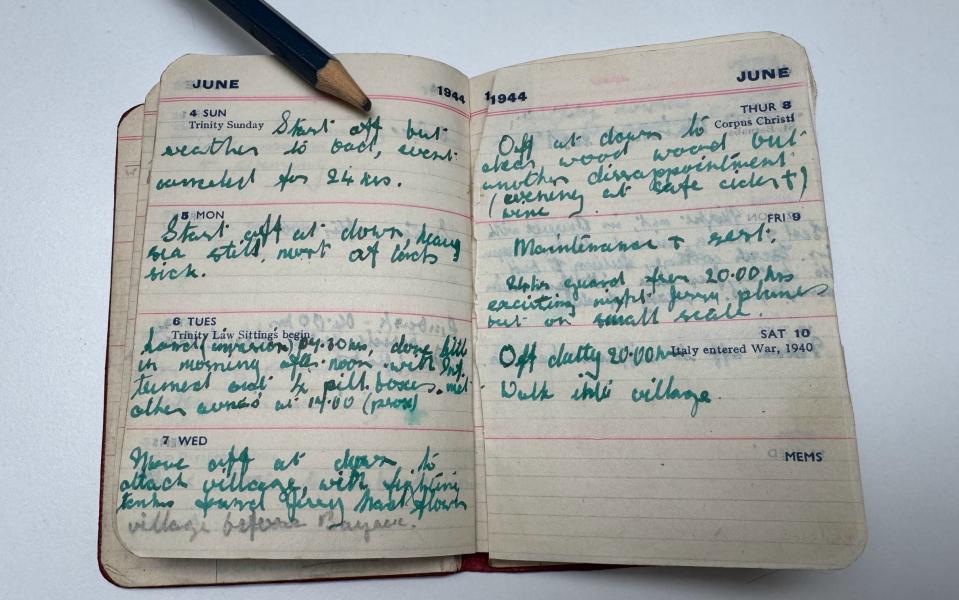
It’s the 80th anniversary of D-Day, with multiple commemorations planned off the coast of Normandy. But it’s also the end of an era. “A few veterans still come, but maybe for the last time,” Aurore Bourget from the Bayeux tourist office told me later. “This will be the last big anniversary.”
Now the commemorative flag needs to be passed on to younger generations. But that’s a challenge: A 2023 UK survey found that 41 percent of millennials don’t know what D-Day was, and only 36 percent believe it’s important to have good knowledge of World War II. After discovering this precious little diary, I definitely wanted to know more.
Some excavation revealed that Jim operated one of the AVREs in the 1st Assault Brigade Royal Engineers, 82nd Assault Squadron. He was in the first wave to land on Gold Beach near the village of Asnelles; His aim was to capture the town of Bayeux, seven miles inland from the coast.
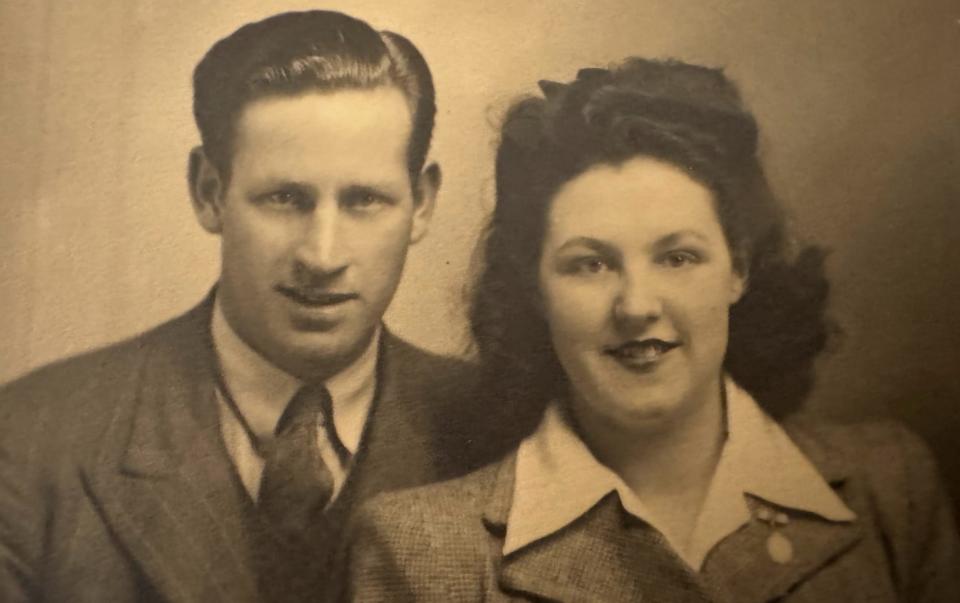

Eighty years later, my husband and I, like Jim, arrived in Normandy early in the morning by boat. But the experience couldn’t have been more different: calm seas, bright skies, a comfortable cabin, breakfast served. There was no enemy to meet us on land; There was only the cheerful Jérôme Barrier of Roulez JEUnesse Loisirs waiting in the port of Ouistreham to deliver a few electric bikes.
Our plan was to spend a few days pedaling west along the Normandy coast via the Vélomaritime cycle path and then head back to Bayeux. We would stop often, looking for connections with Jim. And, for all its historical horrors, this is a beautiful coastline where quiet paths and cycle paths weave between beautiful villas and endless stretches of soft, yellow sand. It should also be enjoyable.
We set off and immediately detoured for coffee, only to find Ouistreham’s main street lined with flagpoles commemorating war heroes. We stopped again at the 70th D-Day commemoration. And then again the statue of Bill Millin, who led his comrades on bagpipes to Sword, the first of five D-Day beaches. At this rate, our journey would take a little longer.
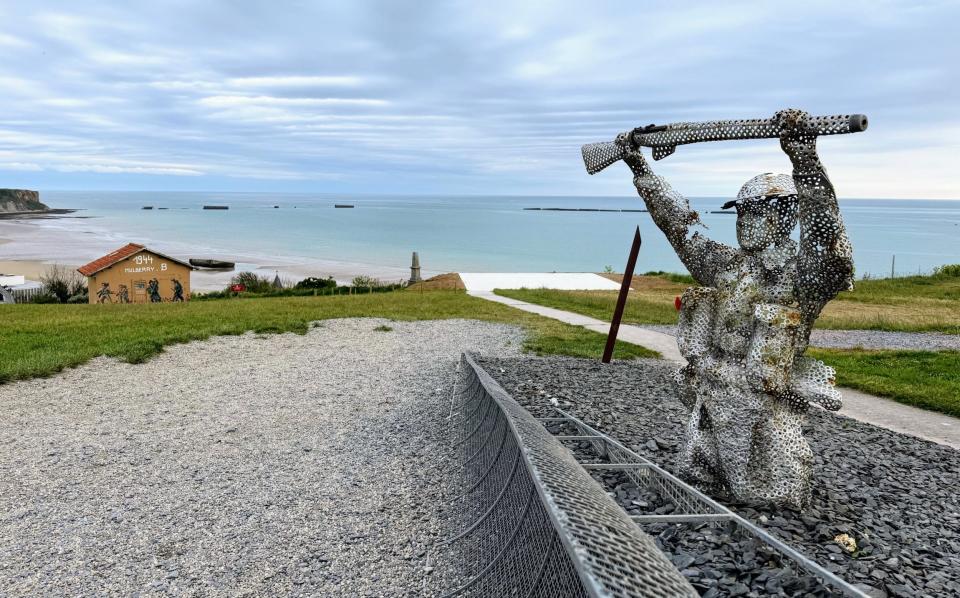

But eventually Sword entered the second landing beach, Juno, and we found ourselves passing by the resort of Courseulles-sur-Mer. After finding my grandfather’s diary, my family also uncovered his copy of his memoir 1st Assault Brigade Royal Engineers 1943-1945; this book reveals that 82nd Squadron assembled near Courseulles in early August 1944 to train for the advance up the Seine. Jim doesn’t elaborate.
The story on Juno is very much a Canadian story; 14,000 Canadian soldiers landed here. It is now home to the Juno Beach Centre, which preserves Canada’s D-Day legacy, focuses on education and attracts young visitors. Exhibits tell age-appropriate stories through technology and gamification, and Canadian student guides lead tours of outdoor German bunkers. But it was the centerpiece that hit the hardest, especially the words of the D-Day veterans: “We’ve never felt so alone”; “Arms, legs, dead, drowned”; “I wanted to cry but I didn’t have time.”
We left feeling somber despite the sunshine, and almost immediately cycled past Churchill AVRE, stranded behind the dunes at Graye-sur-Mer. It was equipped with a mortar, a large, short weapon nicknamed the ‘flying bin’ designed to fire at low speed, short range, to clear bunkers. Jim’s tank was equipped with one of these.
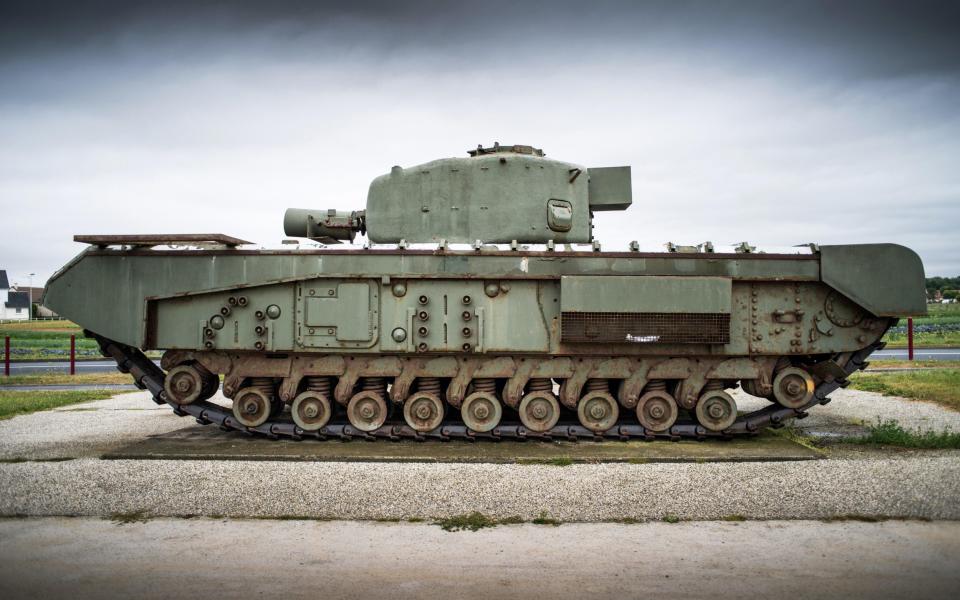

Beyond Graye we were entering Gold, the third D-Day beach. On 6 June 1944, approximately 25,000 British soldiers, including Sapper J Baxter, landed here. But the more chilling figure is 22,442, the number of soldiers who died under British command during the Battle of Normandy. Each of these is honored on the massive British Normandy Memorial, made of limestone, which rises on a hill near Ver-sur-Mer. We went there by bike, talking little. The sun was shining, the sea was turquoise, but the area hit like a hurricane. So many names. Now (until August 31) the monument has an even harsher impact: an installation of 1,475 black silhouettes covers the slope below; this is one for every soldier under British command who died on D-Day.
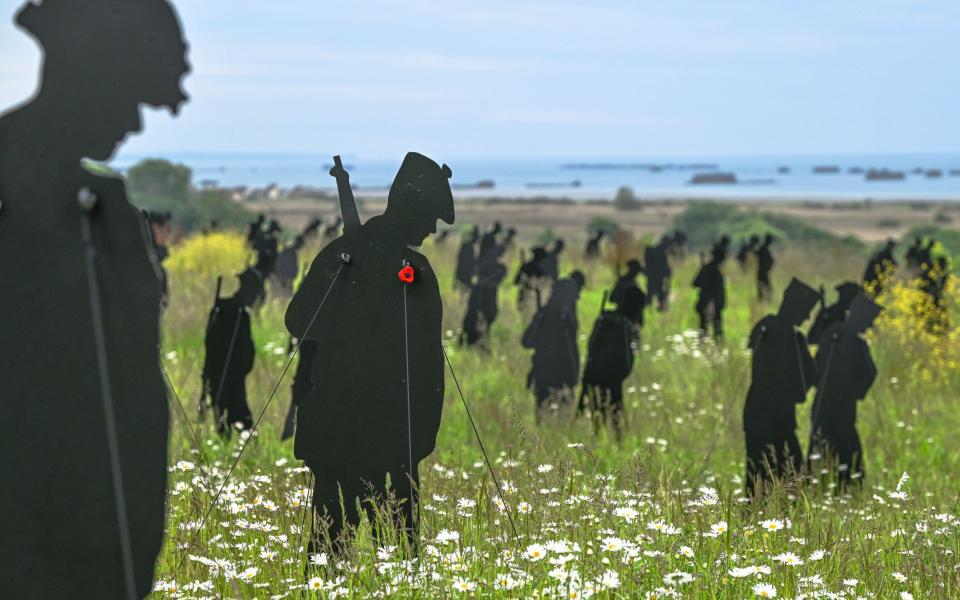

This was enough for a day and we quickly cycled towards Arromanches. We were going back to Gold tomorrow; We needed wine now. At dusk we wandered along the beach, where you couldn’t miss the barnacled ruins of the Allied port of Mulberry B. When we heard the bagpipes, we thought we were dreaming; Bill Millin’s ghost? But no, two men on the pier were blowing their horns amazing Grace Into the wind.
The next day was cloudier but thankfully not too stormy. We were cycling back to Asnelles to meet guide Valentin Fessard to hit the waves ourselves. As we dragged the canoes into the shallow waters, I asked Valentin if the locals constantly thought about D-Day. “Not young people,” he said. “And of course you want to have a happy life. But it’s there in the back of your mind. Especially now, with the way the world is going…”
We paddled against the waves and around the phalanx of sinking Phoenix caissons. These warehouse-sized concrete blocks formed the breakwater of Mulberry B, the brave harbor built to resupply the occupying troops. Its components were withdrawn across the Channel at walking pace from 6 June; the first parts were ready on the 7th; It became operational on the 18th.
“I remember one day – boom! – a caisson collapsed,” Valentin told us. And then it took us through a crack and into a complete crack. Now we were swaying inside its hollow belly, looking at high walls filled with soft anemones. “Caissons are not built to last,” Valentin said. “They will disappear in 30 years”
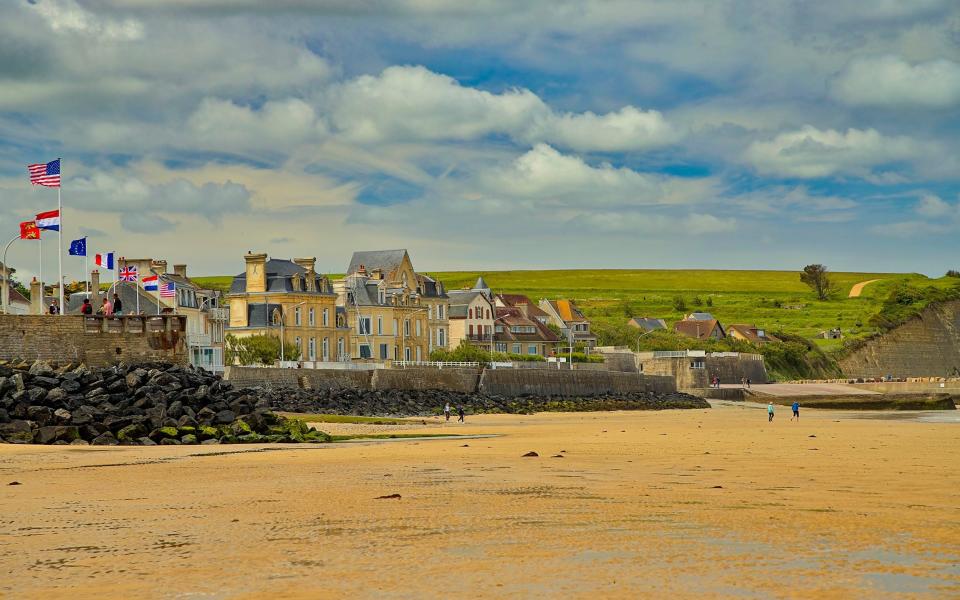

As we turned our canoes towards the beach, I realized that this was it: here, this approach from the sea. Jim’s route – minus any danger. It was impossible to imagine. Back on land, we visited Widerstandsnest 37, the defensive outpost that guarded part of Asnelles and caused trouble for the Allies on D-Day; The blockhouse still stands on the promenade. WN37 was finally neutralized by the Essex Yeomanry at 3pm on 6 June.
However they were aided by the Hampshires and Lance Sergeant Scaife’s AVRE, who lost communication with the rest of 82 Squadron and joined the Hampshires to clear the obstacles. According to reports, LSgt Scaife used his pickaxe against the position with “considerable success”; He was awarded the Distinguished Conduct Medal for his actions. My grandfather was in LSgt Scaife’s AVRE. The Hampshires joined him in the “Inf”; this was one of his “4 pillboxes”.
We continued cycling along the coast to Saint-Laurent-sur-Mer on Omaha Beach, where even more bloody stories took place. But my mind was on Bayeux now. So the next day we pedaled inland in lanes just the width of a tank to reach the medieval city. It’s a beautiful place, with its imposing cathedral and vividly illustrated shop windows for its 80th anniversary. Jim spent nights here. On July 1 he wrote: “ENSA [Entertainments National Service Association] Concert in Bayeux. Swing band.” I was in no mood to dance, especially after visiting the town’s British Military Cemetery, when I found Major HGA Elphinstone, commander of 82 Squadron, among the 4,648 graves. He was killed almost instantly on D-Day.
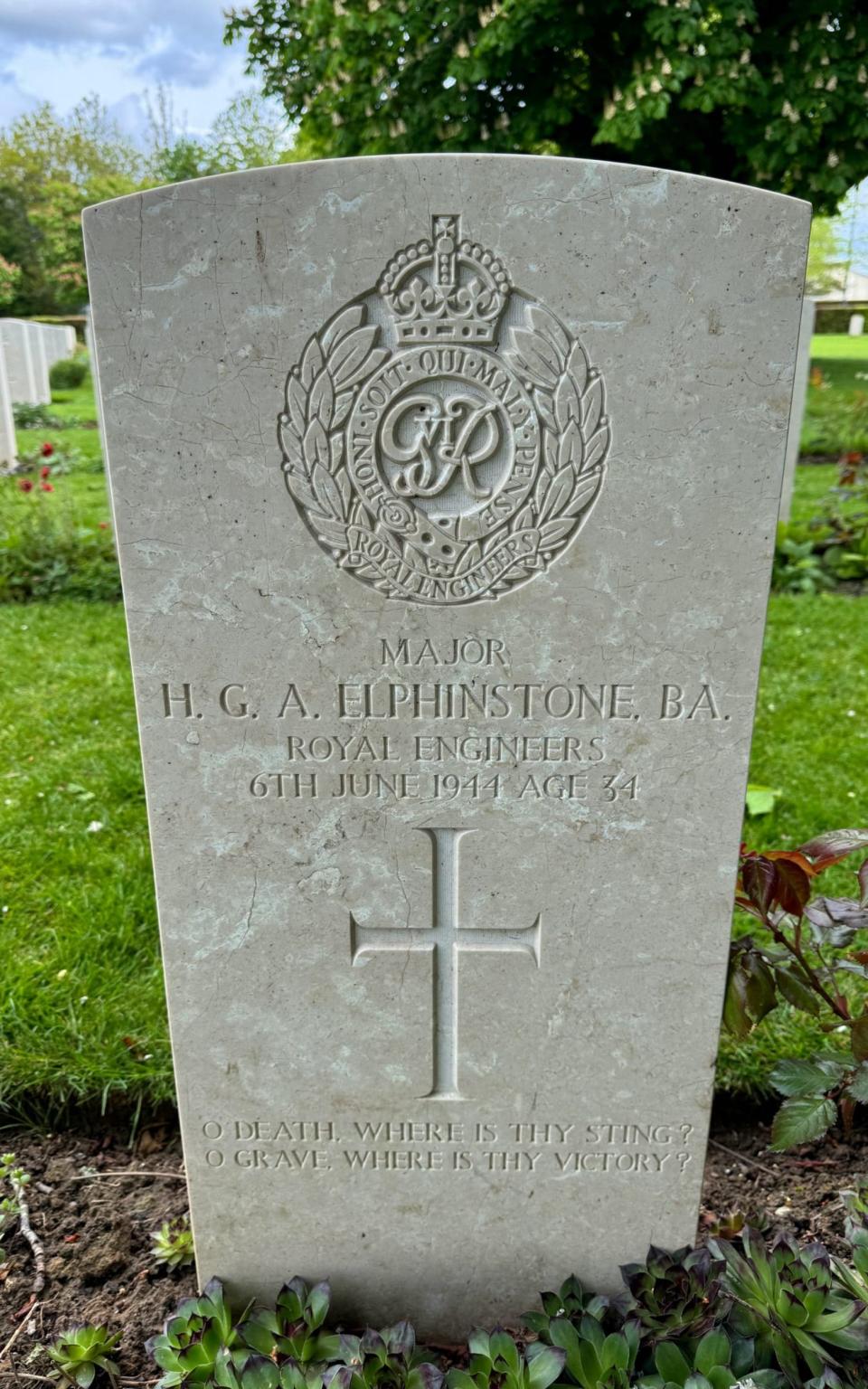

But there was one last place I wanted to go. On June 7, Jim wrote: “Lead out at dawn to attack the village with battle tanks. I found Jerry flying. The village before Bayeux.” Frustratingly vague. However, the Brigade book mentions that the 82nd were “assembled at St Sulpice” on that date. I found it on the map as a speck “before Bayeux”, northeast of the ring road from the direction of Gold Beach. We went.
There was little to see other than the 13th-century church, from which Bayeux’s cathedral towers could be seen in the distance. The church was locked, but we wandered among the graves: Bernard Sallent, born 1932; Therese Blet was born in 1934. Children in 1944. Were they here when the British tanks arrived? Would they remember Jim Baxter and brave men like him? I definitely do.
how to
Brittany Ferries (0330 159 7000; brittany-ferries.co.uk) offers Portsmouth-Caen/Ouistreham return crossings from £98 for foot passengers, or £206 for a car plus two passengers.
Hôtel L’Ideal (hotel-lideal.fr) in Arromanches offers double bed and breakfast from £67pn. La Sapiniere in Saint-Laurent-sur-Mer (la-sapiniere.fr) only has double rooms from £120. Hotel de Brunville (hotel-de-brunville.com) in Bayeux offers bed and breakfast for two from 60p.
E-bike rental costs £29 per day, £70 for three days (roulezjeunesse.bike). Skiing from Asnelles costs £35 per person (charavoile-asnelles.fr).
More information at calvados-tourisme.co.uk; bayeux-bessin-tourisme.com; tr.normandie-tourisme.fr.
Recommended reading includes Bradt’s guide to the D-Day Landings (£9.99; bradtguides.com).